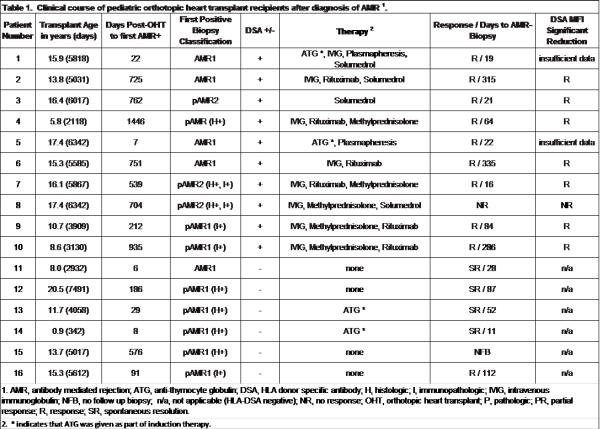Treatment for AMR and DSA: A Center Based Review of Pediatric Orthotopic Heart Transplant Recipients.
1Department of Pediatric Cardiology, UCLA, Los Angeles, CA
2Department of Immunogenetics, UCLA, Los Angeles, CA.
Meeting: 2016 American Transplant Congress
Abstract number: B153
Keywords: Antibodies, Pediatric, Rejection
Session Information
Session Name: Poster Session B: Hearts and VADs in Depth - The Force Awakens
Session Type: Poster Session
Date: Sunday, June 12, 2016
Session Time: 6:00pm-7:00pm
 Presentation Time: 6:00pm-7:00pm
Presentation Time: 6:00pm-7:00pm
Location: Halls C&D
PURPOSE: The aim of this study was to retrospectively analyze the clinical course of pediatric orthotopic heart transplant patients diagnosed with antibody mediated rejection (AMR+) at UCLA based on endomyocardial biopsy.
METHODS: Charts of 82 patients transplanted from 2010-2015 were analyzed for results of right ventricular endomyocardial biopsies, immune-modulatory therapy for AMR, and strengths/specificities of HLA DSA identified by single antigen bead assay (positive threshold 1000 MFI). Response to therapy was defined as negative for AMR at follow-up biopsy (AMR-). 50% reduction in strength (MFI) of a DSA occurring within 6 months of treatment was significant.
RESULTS: Sixteen of 82 patients were AMR+ (19.5%) with first positive biopsy occurring a median of 376 days (d; range: 6-1446d) post-OHT (Table 1). DSA were identified at time of AMR in 10/16 patients (62.5%, AMR+DSA+). AMR+DSA+ patients were treated for AMR, while AMR+ patients without DSA (AMR+DSA-, n=6, 37.5%) did not receive additional treatment. Follow-up AMR- biopsies were available in 10/10 AMR+DSA+ patients who received immune-modulating therapy indicating response to therapy (R). Only one AMR+DSA+ patient did not respond to therapy (NR). Median time to AMR- biopsy in the AMR+DSA+ group was 64d (range: 19-315d). Follow-up biopsies in AMR+DSA- patients were available for 5/6 patients and all five showed resolution of AMR a median of 52d after initial AMR+ biopsy (range: 11-112d). Majority of patients had multiple DSA (median: 4, range: 1-11). Strength of DSA was assessed during course of treatment in 8/10 AMR+DSA+ patients. A significant reduction in the strength of DSA was evident in 7/8 patients for DSA with median strength of 3582 MFI (range: 1203-12087) while strong DSA were not amenable to immunomodulation (median strength: 13715, range: 3416-16257).
CONCLUSION: The majority of AMR+ patients were also DSA+ and responded to therapy with negative biopsy and reduction in DSA strength. DSA amenable to immunomodulatory therapy were generally weak to moderate strength while strong DSA were unaffected. 
CITATION INFORMATION: Drogalis-Kim D, Hickey M, Alejos J, Reed E, Halnon N. Treatment for AMR and DSA: A Center Based Review of Pediatric Orthotopic Heart Transplant Recipients. Am J Transplant. 2016;16 (suppl 3).
To cite this abstract in AMA style:
Drogalis-Kim D, Hickey M, Alejos J, Reed E, Halnon N. Treatment for AMR and DSA: A Center Based Review of Pediatric Orthotopic Heart Transplant Recipients. [abstract]. Am J Transplant. 2016; 16 (suppl 3). https://atcmeetingabstracts.com/abstract/treatment-for-amr-and-dsa-a-center-based-review-of-pediatric-orthotopic-heart-transplant-recipients/. Accessed December 13, 2025.« Back to 2016 American Transplant Congress
